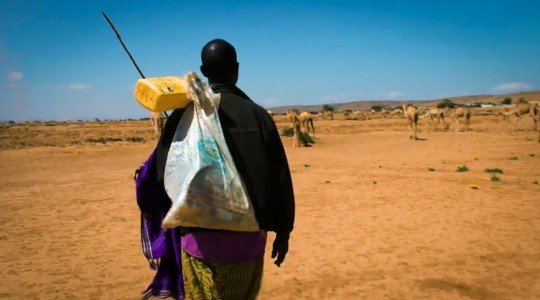This blog originally appeared on UNDP
16 Jun 2017 by Phemo Kgomotso, Regional Technical Specialist, Ecosystems and Biodiversity, UNDP Regional Service Centre for Africa
Would forced migration end, if people knew that they could survive and thrive in their homeland?
The United Nations Convention to Combat Desertification (UNCCD) asks this pertinent question as we observe World Day to Combat Desertification on 17 June, focused on examining the important link between land degradation and migration.
A childhood memory that has stayed with me is from 1992, when Botswana, along with many other countries in southern Africa were hit by what the New York Times called 'the worst drought of the 20th Century'.
That year, on a hot and dry December day, one of my family members and I spent half a day trekking livestock to the only water source that hadn’t dried up, and another half day trekking back to my grandmother’s farmstead. That year, my family lost over 40 heads of cattle.
Mainly dependent on livestock for subsistence, people living in drylands and other marginal landscapes have always lived with uncertainty and livelihood insecurities and constraints presented by such environments.
Over time, they have employed a myriad of coping strategies, including seasonal migration in search of food, pasture and water.
The Fulani herders, found in Nigeria, Niger, Guinea, Mali and many parts of the Sahel and West Africa still migrate in search of pasture for their livestock. My own uncles still relocate cattle to areas with better pastures almost every year during the dry season.
Many of these coping strategies have increasingly come into conflict with the more sedentary approaches to agriculture and land use, and are incompatible with ‘modern’ policies and land tenure systems.
The lack of alternatives has in many cases led to poverty, food insecurity, conflict and increasingly outward migration to urban areas.
Two greatest environmental concerns
Land degradation is the reduction or loss in the capacity of soil and land resources to produce food, fodder and other ecosystems services, and desertification is land degradation that occurs in drylands.
It directly impacts the health and livelihoods of an estimated 1.5 billion people globally.
Additional pressure comes from the need to feed a growing global population of over 7 billion requiring food to be produced fast, cheaply and in large quantities.
However, land degradation need not be permanent. Restoration will not be cheap, but the costs of inaction will be even higher.
The UNCCD says that restoring just 12 percent of degraded agricultural land could boost smallholders’ incomes by US$35 billion to $40 billion per year and feed 200 million people annually within 15 years.
Where will the money come from?
Will the money come from the poor Asian and African smallholder farmers who on average own and cultivate just 2.5 hectares to produce 80 percent of the food consumed in these two regions? What are the opportunity costs of adopting sustainable land management practices? What is the role of public funding in making these investments and what should be the role of the private sector in overcoming the investment barriers?
As we pursue the Sustainable Development Goals together with our partners, including the Global Environment Facility, we are exploring answers to some of these questions and leading dialogue and action towards achieving SDG target 15.3 - a land degradation neutral world.
We support 143 countries around the world to address land degradation and other global environmental challenges by assisting them to plan, access, deliver, diversify, scale-up and sequence a variety of environmental financing mechanisms, and combine these with other sources of public and private financing.
Since that big drought year in Botswana, which is also the same year that the world met in Brazil and agreed on the UNCCD and the other Rio Conventions, UNDP has helped mobilize $6.6 billion from various sources to implement the actions agreed under the Rio Conventions and to support sustainable environmental practices around the globe, with clear benefits that advance sustainable development.
The links between land degradation and migration have not always been boldly stated, but they are certainly there, and we need more nuanced research and analysis to better inform responses.
Photo: UNDP Somalia

